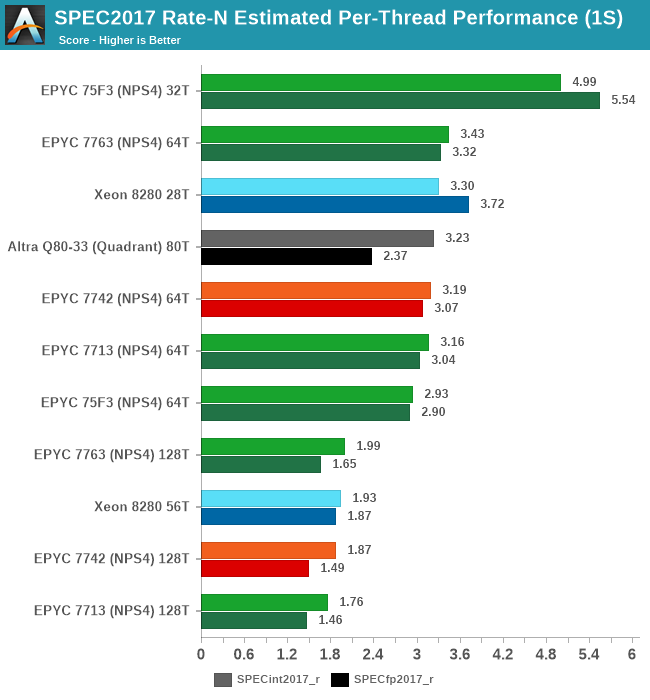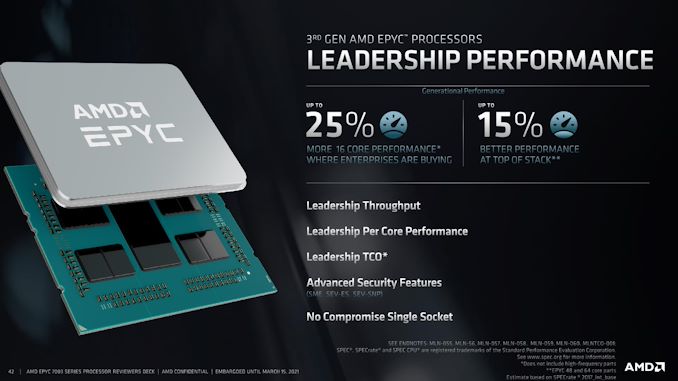AMD 3rd Gen EPYC Milan Review: A Peak vs Per Core Performance Balance
by Dr. Ian Cutress & Andrei Frumusanu on March 15, 2021 11:00 AM ESTDisclaimer June 25th: The benchmark figures in this review have been superseded by our second follow-up Milan review article, where we observe improved performance figures on a production platform compared to AMD’s reference system in this piece.
SPEC - Per-Core Win for "F"-Series 75F3
A metric that is actually more interesting than isolated single-thread performance, is actually per-thread performance in a fully loaded system. This actually is a measurement and benchmark figure that would greatly interest enterprises and customers which are running software or workloads that are possibly licensed on a per-core basis, or simply workloads that require a certain level of per-thread service level agreement in terms of performance.
It’s precisely this market that AMD is trying to target with its new “F”-series of processors, and this is where the new 75F3 comes into play. With 32 cores, 4 cores per chiplet with the full 256MB of L3 cache, and a base frequency of 2.95GHz, boosting up to 4.0GHz at a default 280W TDP, is the chip is squeezing out the maximum per-core performance while still offering a massive amount of multi-threaded performance.

At full load, this ends up with a massive per-thread performance leadership on the part of the 75F3, landing 45% ahead of the 7763 and 51% ahead of the Intel Xeon 8280.
It’s to be noted that limiting the thread count of the higher core-count SKUs will also result in a better per-thread performance metric, for example running a 7713 with only 32 threads will result in a SPECint2017 estimated score of 4.30 – the 75F3 still has a 16% advantage there even though its boost clock is only 8.8% higher at the peak – meaning the 75F3 is achieving higher effective frequencies. Unfortunately, we didn’t have enough time to do the same experiment on the equal 280W 7763 part.
AMD discloses that the biggest generational gains for the Milan stack is found in the lower core-count models, where for example the 7313 and the 7343 outperforms the 7282 and 7302 by 25%. Reason for this is that for example the new 7313 features double the L3 cache, and all the new CPUs are boosting higher with respectively higher TDPs, increasing to 150/190W from 120/155W, as well as landing in at +50% higher price points when comparing generation to generation.











120 Comments
View All Comments
eva02langley - Monday, March 15, 2021 - link
You probably looking at the blue lines (Intel)... just saying...Targon - Monday, March 15, 2021 - link
Compared to what? Core count not increasing, but Zen3 is still a big improvement when it comes to IPC compared to Zen2.mode_13h - Monday, March 15, 2021 - link
We can hope that they find some microcode fixes to improve power allocation, and maybe a mid-cycle refresh with an updated I/O die.Spunjji - Friday, March 19, 2021 - link
How surprising, an Intel fanboy is unimpressed.Wilco1 - Sunday, March 21, 2021 - link
It's actually an impressive improvement. However Milan is getting power and memory bandwidth limited. It will take a new process and DDR5 to achieve significantly more performance.ballsystemlord - Monday, March 15, 2021 - link
Spelling and grammar errors:"As the first generation Naples was launched, it offered impressive some performance numbers."
Rearange words:
"As the first generation Naples was launched, it offered some impressive performance numbers."
"All of these processors can be use in dual socket configurations."
"used" not "use":
"All of these processors can be used in dual socket configurations."
"... I see these to chips as the better apples-to-apples generational comparison, ..."
"two" not "to":
"... I see these two chips as the better apples-to-apples generational comparison, ..."
"There is always room for improvement, but if AMD equip themselves with a good IO update next generation,..."
Missing "s":
"There is always room for improvement, but if AMD equips themselves with a good IO update next generation,..."
eva02langley - Monday, March 15, 2021 - link
If business don't buy EPYC by then, than they deserve all the issues coming with Intel CPUs.Otritus - Monday, March 15, 2021 - link
Milan's IO die really seems to be the Achilles heel of these CPUs. Perhaps AMD should have segregated the line up into superior memory performance and features Milan IO die and superior compute performance (but inferior features) Rome IO die.Targon - Monday, March 15, 2021 - link
The Zen4 generation will make the move to DDR5 memory, so new memory controller, socket, and other aspects. Also, as time goes on, the contracts with Global Foundries for how much they make for AMD will expire. As it stands now, the use of Global is entirely to fulfill the contracts and avoid paying any early termination fees.Calin - Tuesday, March 16, 2021 - link
TSMC still can not make enough chiplets (I think its production is sold until 2023).Using Global Foundry IO dies means AMD can make one 8+1 instead of 8 processors (or 4+1 instead of 4).